Your Call?
Which two of today’s nine featured images are your favorites? Why do you like each one?
Thanks to the many who commented at the last post. The majority picked the first images as best while admitted that they loved the second image, the goofy looking crane colt staring right at me. I will follow up Cliff Beittel’s excellent suggestion that I lighten the irises of the colt in the vertical.
Tariff Warnings
In the face of tariff concerns, there is lots online about possible huge price increases for photography equipment — cameras and lenses and more. There was one doomsday report on Facebook stating definitively that a $700 price increase on the Sony 400-800 lens is already in place. That is pure BS. When Dr. Cliff Oliver posted that he ordered one on Wednesday from Bedfords using the BIRDSASART discount code, received the lens on Friday for the current price — $2898.00, got his BAA discount and free second-day air Fed Ex shipping, his comment was of course deleted.
I spoke to Steve Elkins last week and he stated that as long as Sony does not raise the prices on future delivered stock items that he will honor the currently posted prices. If Sony jacks up the current prices, buyers will be notified of the price increase and asked if they would like to go through with their purchase.
B&H states clearly that if you place an order at a given price, they will honor that price when your item or items are delivered even if Sony raises the price. And the same, of course, goes with backordered stuff including and especially the Sony a-1 ii and the 400-800.
So, if you are considering purchasing a Sony a-1 ii, a Sony 400-800, or any camera, lens, or accessory, my advice at this minute is to stop what you are doing and place your order right now (using one of my two affiliate links of course). Or risk paying appreciably more at some point. Please remember that you only live once.
As noted the other day, the pipeline on the a-1 ii is beginning to open up and you can get a 400-800 soon with a bit of luck.
Very recently Patrick Sparkman, Geri Georg, Charlie Curr, and Bryan Love received their a-1 ii bodies and Cliff Oliver and Ramona Boone got their 400-800s, all from Bedfords. Bedford’s wait lists are always shorter than the B&H lists.
What’s Up?
Friday morning on the Osprey boat was fabulous with a brisk east wind and some sweet light. Saturday morning began well but when the wind died, so did the action. Clemens Van der Werf joined Anita North and me both days.
In the very early mornings when I am done trying to create a good pleasing blur or two, I go to either the 300mm f/2.8 GM or the 400mm f/2.8 GM when I start trying to create sharp images. Those often with the 1.4X TC in place. But as soon as it is bright enough to work with my favorite new lens, I grab the 400-800 and get to work. Be sure to check out the amazing variety of images that can be made with Sony’s fabulous new monster zoom.
On Sunday morning Anita and I headed down to Lake Walk-in-Water to check on the baby cranes and lots more. A flock of about 80 Black-bellied Whistling Ducks flew in left of the pier very early; we got some nice stuff on them in the low light before they flew off. Last year this species provided a ton of action in May and early June and things are looking very positive for a 2025 repeat. Neighbor Ron told us weeks ago that the had seen eleven young cranes this year. I did not believe him until this morning when I saw all eleven! We photographed several pairs of chicks and small colts.
Today in Monday 28 April 2028. We will, of course, be heading down to the lake in the dark to see what’s around. Whatever you opt to do, I hope that you too choose to have a wonderful and productive day. Do remember that happiness is a choice — Byron Katie, The Work.Com.
If an item — a Delkin flash card or a Levered-clamp FlexShooter Pro — for example, that is available from B&H and/or Bedfords, is also available in the BAA Online Store, it would be great, and greatly appreciated, if you would opt to purchase from us. We will match any price. Please remember also to use my B&H affiliate links or to earn 3% cash back at Bedfords by using the BIRDSASART discount code at checkout for your major gear purchases. Doing either often earns you free guides and/or discounts. And always earns my great appreciation.
Don’t Just Shoot: Learn
If you are interested in changing your life and becoming a better photographer by joining me on an Extended IPT at Sebastian Inlet for Ospreys and more (SEPT 25 to NOV 24, 2025) or in San Diego for Pacific-race Brown Pelicans and more (JAN 6 to FEB 2, 2026), please e-mail for dates, rates, terms, and additional information. Or shoot me a text to 863-221-2372. Both offerings include options for shared AirBnB lodging and ground transportation during your stay.
Indian Lake Estates BAA Baby Crane In-the-Field Sessions
I am currently available for morning BAA Baby Crane In-the-Field sessions on the following dates: April 29-30 and at least the first half of May. Please e-mail for costs and additional information. Or, shoot me a text to 863-221-2372.
BILD EXPO Presented by B&H
Why Attend? Speakers, Gear, Deals, and More!
Bild Expo is back! Join us at The Javits Center in New York City for an unforgettable event featuring 100+ expert speakers, 250+ exhibitors, hands-on experiences, and the world’s greatest creative community. B&H’s incredible show specials will be the icing on the cake! Whether you’re a seasoned pro, an enthusiast, or a beginner, at Bild you will get inspired, learn, meet like-minded people, and celebrate being part of this amazing world of creativity.
Click here or on the logo link above for more information.
Click here to register.
|
|
|
This image was created on 18 April 2025 at Lake Blue Cypress. I used the hand held Sony FE 400-800mm f/6.3-8 G OSS lens (Sony E) (at 678mm) and The Latest Greatest Sony Flagship Body, the a1 II Mirrorless Camera. The exposure was determined by Zebras with ISO on the rear wheel — ISO 1250: 1/1600 second at f/8 (wide open) in Manual mode. RawDigger showed that the exposure was perfect. AWB at 9:20:30 am on a bright sunny morning. Tracking: Spot XS/AF-C with Bird-Eye/Face Detection performed perfectly. Click on the image to enjoy the larger, inexplicably sharper high-res version. Image #1: American Alligator head and snout portrait |
Lissy’s Favorite
Younger daughter Alissa was thrilled to see this nine foot gator after we got off the Osprey boat on the family outing nine days ago. When I first spotted it basking on the exit road, I grabbed my 400-800 for the reach. It turned out to be the perfect lens choice.
|
|
|
This image was created on 25 April 2025 at Lake Blue Cypress. I used the hand held Sony FE 400-800mm f/6.3-8 G OSS lens (Sony E) (at 455mm) and The Latest Greatest Sony Flagship Body, the a1 II Mirrorless Camera. Multi-metering +2.7 stops in Shutter Priority mode with Exposure Compensation (EC) on the Thumb Dial. AUTO ISO set ISO 4000: 1/10 sec. at f/6.3 (wide open) in Shutter Priority mode. Wide/AF-C with Bird-Eye/Face Detection performed perfectly. Click on the image to enjoy the larger, inexplicably sharper high-res version. Image #2: Mythical Cypress Tree/Osprey landing on water |
Mythical Cypress Tree/Osprey
Creating blurs is like a box of chocolates. You never know what you’re going to get. As I do not like to sit around doing nothing in extreme low light situations with a camera and lens in my hands. Waiting around for enough light to create sharp images is a complete waste of time. Thus, I am a huge fan of trying to create pleasing blurs. I was working on jiggle blurs of the Cypress Trees at 1/10 second. I kept four traditional jiggle blurs plus this totally serendipitous one.
Not only does this mythical bird have two wings, it even has the crest of feathers that can be seen at times on the back of an Osprey’s head.
|
|
|
This image was created on 25 April 2025 from a pontoon boat at Lake Blue Cypress. I used the hand held Sony FE 400-800mm f/6.3-8 G OSS lens (Sony E) (at 423mm) and The Latest Greatest Sony Flagship Body, the a1 II Mirrorless Camera. The exposure was determined by Zebras with ISO on the rear wheel — ISO 2500: 1/4000 second at f/8 (wide open) in Manual mode. RawDigger showed that the exposure was perfect. AWB at 7:52:11am on a sunny morning. Wide/AF-C with Bird-Eye/Face Detection performed perfectly. Click on the image to enjoy the larger, inexplicably sharper high-res version. Image #3: Osprey — female taking flight |
400-800 at the Short End
The incredible versatility of the 4-8 makes up for its lack of speed (f/6.3 to f/8). Zooming out practically all the way was the winning move for this image. A quarter-turn twist of the wrist get you from 400mm to 800mm and back again just as easily.
|
|
|
This image was created on 25 April 2025 from a pontoon boat at Lake Blue Cypress. I used the hand held Sony FE 400-800mm f/6.3-8 G OSS lens (Sony E) (at 800mm) and The Latest Greatest Sony Flagship Body, the a1 II Mirrorless Camera. The exposure was determined by Zebras with ISO on the rear wheel — ISO 2000: 1/5000 second at f/8 (wide open) in Manual mode. RawDigger showed that the exposure was perfect. AWB at 8:12:39am on a sunny morning. Tracking: Spot XS/AF-C with Bird-Eye/Face Detection performed perfectly. Click on the image to enjoy the larger, inexplicably sharper high-res version. Image #4: Osprey feeding two chicks |
A Huge Crop
With a fairly brisk wind and the boat rocking considerably, I was having trouble keeping the adult bird in the middle of the frame and acquiring and maintaining focus. I did manage to create more than a few sharp frames; this was the best of the lot. Clemens was shooting at 1200mm and Anita wound up at 1600mm (400-800 at 800mm with the 2X TC at f/16!). I am not sure how they did it, but they both made some very good images.
Sharp a-1 ii raw files allow for very large crops and that is exactly what I needed to create a presentable image.
|
|
|
This image was created on 25 April 2025 from a pontoon boat at Lake Blue Cypress. I used the hand held Sony FE 400-800mm f/6.3-8 G OSS lens (Sony E) (at 800mm) and The Latest Greatest Sony Flagship Body, the a1 II Mirrorless Camera. The exposure was determined by Zebras with ISO on the rear wheel — ISO 1600: 1/5000 second at f/8 (wide open) in Manual mode. RawDigger showed that the exposure was perfect. AWB at 8:27:18am on a sunny morning. Wide/AF-C with Bird-Eye/Face Detection performed perfectly. Click on the image to enjoy the larger, inexplicably sharper high-res version. Image #5: Osprey in nest adorned with fall color Cypress bough |
Fall Color Nest
A very few nests had orange sprigs of left-over fall color mixed in with the sticks and the Spanish moss. Staying well back and working at 800mm allowed for a rather shallow angle of inclination and the handsome Osprey was the icing on the cake. The performance of Wide/AF-C with Bird-Eye/Face Detection enabled is quite remarkable. It is so good that I have eliminated both Zone and Tracking: Zone on nothing of my a-1 ii bodies. That leaves me with only two check-boxed AF patterns — Wide and Tracking: Spot XS.
|
|
|
This image was created on 25 April 2025 from a pontoon boat at Lake Blue Cypress. I used the hand held Sony FE 400-800mm f/6.3-8 G OSS lens (Sony E) (at 800mm) and The Latest Greatest Sony Flagship Body, the a1 II Mirrorless Camera. The exposure was determined by Zebras with ISO on the rear wheel — ISO 1600: 1/5000 second at f/8 (wide open) in Manual mode. RawDigger showed that the exposure was perfect. AWB at 8:27:50am on a sunny morning. Wide/AF-C with Bird-Eye/Face Detection performed perfectly. Click on the image to enjoy the larger, inexplicably sharper high-res version. Image #6: Osprey — head portrait of bird in nest |
Same Bird
The bird in Image #5 is the very same bird in the very same spot as the bird in Image #4. Only the perspective is different. Despite the steep angle of inclination, I find this one pleasing. And again, we see the amazing versatility of the Sony 400-800.
|
|
|
This image was created on 25 April 2025 from a pontoon boat at Lake Blue Cypress. I used the hand held Sony FE 400-800mm f/6.3-8 G OSS lens (Sony E) (at 604mm) and The Latest Greatest Sony Flagship Body, the a1 II Mirrorless Camera. The exposure was determined by Zebras with ISO on the rear wheel — ISO 2000: 1/5000 second at f/8 (wide open) in Manual mode. RawDigger showed that the exposure was perfect. AWB at 8:39:37am on a sunny morning. Wide/AF-C with Bird-Eye/Face Detection performed perfectly. Click on the image to enjoy the larger, inexplicably sharper high-res version. Image #7: Osprey — male landing at nest |
A Very Good Wind
The wind was close to perfect on Friday morning, 12-15mph from the east with a touch of south in it as the morning wore on. The result: lots of action and lots of take-offs and landings.
|
|
|
This image was created on 25 April 2025 from a pontoon boat at Lake Blue Cypress. I used the hand held Sony FE 400-800mm f/6.3-8 G OSS lens (Sony E) (at 414mm) and The Latest Greatest Sony Flagship Body, the a1 II Mirrorless Camera. The exposure was determined by Zebras with ISO on the rear wheel — ISO 2500: 1/4000 second at f/8 (wide open) in Manual mode. RawDigger showed that the exposure was perfect. AWB at 8:45:24am on a partly sunny morning. Wide/AF-C with Bird-Eye/Face Detection performed perfectly. Click on the image to enjoy the larger, inexplicably sharper high-res version. Image #8: Osprey — female taking flight from a vertical original |
Trying for Vertical Takeoff Shots
When most birds take flight, their first move is often to raise both wings straight overhead. So, when working at fairly close range, it often pays to try for the vertical take off shot. With the bird well up in the original frame, I went to a full width square crop with this one.
|
|
|
This image was created on 26 April 2025 from a pontoon boat at Lake Blue Cypress. I used the hand held Sony FE 400-800mm f/6.3-8 G OSS lens (Sony E) (at 800mm) and The Latest Greatest Sony Flagship Body, the a1 II Mirrorless Camera. The exposure was determined by Zebras with ISO on the rear wheel — ISO 6400: 1/1000 second at f/8 (wide open) in Manual mode. RawDigger showed that the raw file brightness was two stops too dark. AWB at 6:55:46am — five minutes before sunrise with single cloud on the eastern horizon. Wide/AF-C with Bird-Eye/Face Detection performed perfectly. Click on the image to enjoy the larger, inexplicably sharper high-res version. Image #9: Peregrine perched in Cypress tree |
Whoa, Don. Stop the Boat!
We were cruising slowly looking for good situations in the extreme low light of dawn when I spotted the distinctive shape of a Peregrine perched low in a small Cypress tree. As I was in a bit of a hurry as the captain approached the falcon, I grabbed the 400-800 that was set up for doing blurs, switched to Manual mode, set 1/1000 sec. as my hopefully-sharp-enough-shutter speed, raised the ISO to 6400 (knowing that I would be way under-exposed but not wanting to go any higher), and created a few frames. This one was the sharpest of the lot.
If I had had time, it would have been better to grab the 400mm f/2.8 and add the 2X TC to save one full stop of ISO. As my late Mom used to say, “Oh well.”
The Sony 400-800mm G Zoom Lens — Slow, a Bit on the Heavy Side: But With New, Different, and Spectacular Results!
I did not think that I would like this lens — too heavy, too slow. Instead, I have fallen in love with it.
I learned three new things about Sony’s big zoom last Monday:
1- It is the first and, as far as I know, the only Sony G lens to offer a Direct Manual Focus (DMF) switch. This is a huge plus as it allows you to pre-focus manually with the AF switch set to AF. All GM super-telephotos have a DMF switch. The 200-600 G lens does not have a DMF switch.
2- Sony switched the design of the mounting holes on the new lens. It will take some research to come up with a suitable low foot. Note: the lower the foot, the better the performance of the lens on a tripod topped by a Levered-clamp FlexShooter Pro.
3- Optically, the 4-8 with the 1.4X TC is superb. At f/11, this is of course a very slow combination, but on sunny days, brilliant results can be achieved. Note that at 1/500 second, I needed ISO 2000 to come up with a perfect exposure, that despite the abundance of sunshine. More recently, Anita North made some sharp Osprey feeding young images with here 4-8 with the 2X TC at 1600mmm at f/16. From a rocking boat!
I’ve continued to use the new 4-8 more and more at various locations. Working in Manual mode, I need to be at f/8 to avoid any exposure screw-ups. The high shutter speeds needed for flight and action find me working with ISOs ranging from 1600 to 2500 (or more for dark subjects) even in bright conditions. It goes without saying, however, that the relatively low maximum aperture of f/8 is a handicap in cloudy conditions. But the images are the payoff.
Huge thanks to Anita North, Larry Master, and Pamela Viale, who each used A BAA affiliate link to order their Sony FE 400-800mm f/6.3-8 G OSS lenses. Pam is pairing her 4-8 with her 300mm f/2.8 (plus both TCs); that seems like a perfect marriage to me. Each of them and everyone else who uses either my B&H link or the BIRDSASART discount code at checkout with Bedfords to purchase their 400-800 will receive a free lens guide in approximately three weeks. If you are confused as to using the links, please e-mail for details.
Those who do not use a BAA affiliate link to purchase their 400-800s will be able to purchase the 400-800 lens guide by sending a PayPal for $101.43 to birdsasart@verizon.net. I am bringing my 400-800 to the Alligator Farm and will be using it on a tripod for the first time. For now, the Wimberley P-35 Plate is the best option.
Should You Upgrade to or Purchase a Sony a-1 ii?
I received my second a-1 ii two weeks ago. I continue to be amazed by speed and accuracy of the Bird Face-Eye tracking in AF-C and the overall performance of the camera. I feel blessed every time I pick one up.
Aside from the improved ergonomics as compared to the a-1, other nice features include the fact that the rear screen tilts both ways. Pre-capture has proven to be a huge plus; in my opinion, the Speed Boost feature is a total waste for bird photography. In addition, the resolution on the rear monitor has been improved dramatically (not that I would notice). Bird Face-Eye tracking on the a-1 ii is vastly improved as compared to both the a-1 and the a9 iii and the 51MP files are to die for.
So, the big question is, is the a-1 ii “worth” a gear upgrade. Remember that I can never know whether or not something is worth it to for someone else. I can say that I was not floored when first using my a-1 ii. The differences between the a-1 ii and the original a-1, seemed to be neither huge nor eye-opening. But over time, I came to realize that I was 100% wrong.
The huge difference between the new camera body and the older a9 iii is, of course, the 51MP a-1 raw files (as compared to the 24MP files rendered by the a9 iii). That said, Pat’s image above stood up quite well to a rather substantial crop from below and from our left.
With the price of a brand new a-1 having recently dropped $1500.00 to $4,998.00, the decision for new Sony buyers is a tough one. The a-1 ii sells new for $6,498.00. And the price of used a-1 bodies will continue to drop (but surely not as much as I had thought before using the a-1 ii). But for me, the a-1 ii is clearly far superior to the original a-1 for bird photography.
If you do purchase an a-1 ii, be sure to use one of my two affiliate links so that you will receive my a-1 ii settings (in the form of a CAMSEa1ii.DAT file), the Buttons and Dials Guide, and an Info Sheet. Folks who do not purchase their new a-i ii using my B&H link or from Bedfords here and entering the BIRDSASART discount code at checkout will be able to purchase the a-1 ii guide for $227.43. If you are at all confused and do not want to screw up your order, please get in touch via e-mail.
Typos
With all blog posts, feel free to e-mail or to leave a comment regarding any typos or errors.


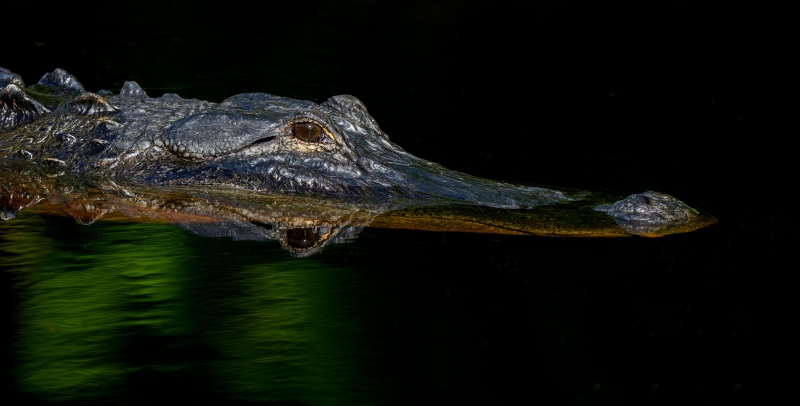
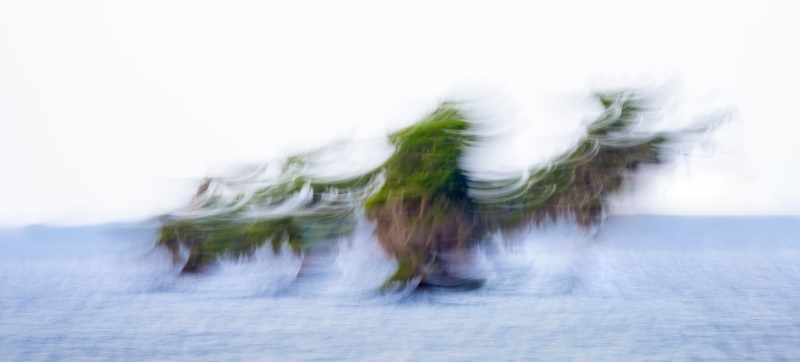
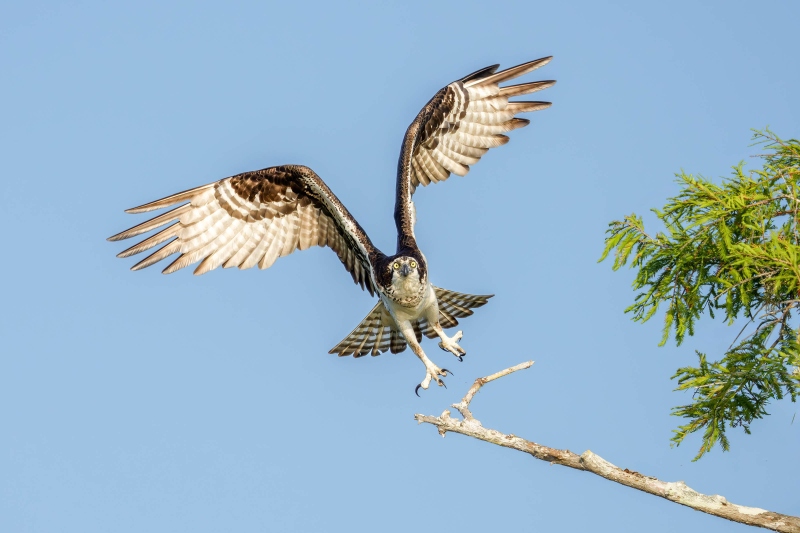
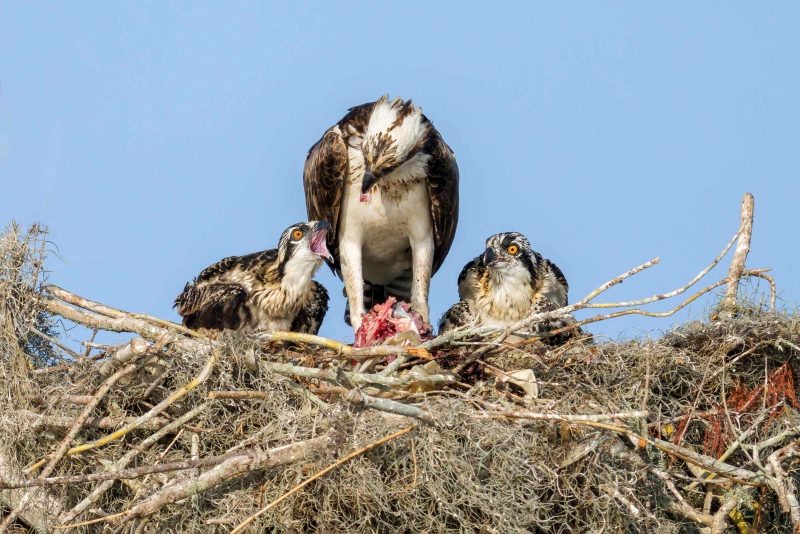
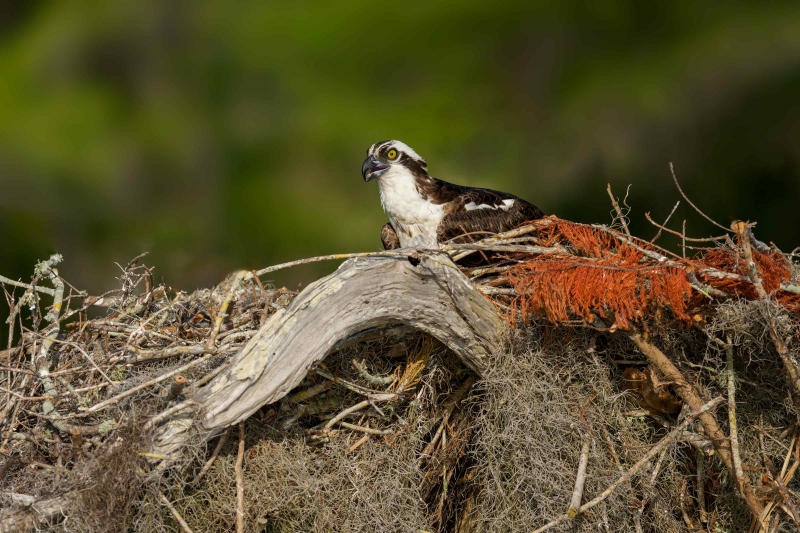
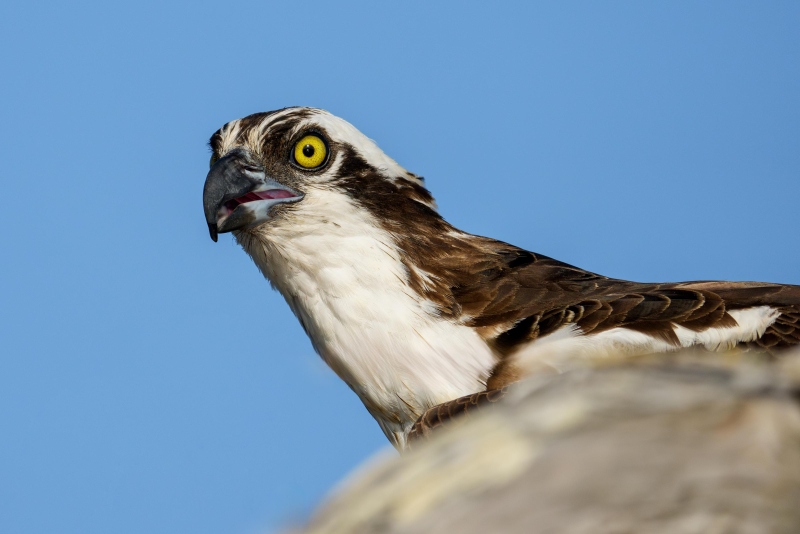
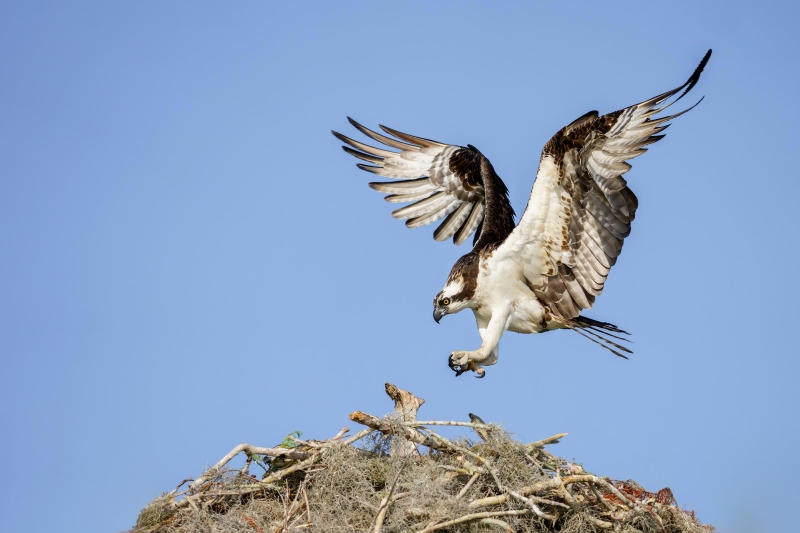
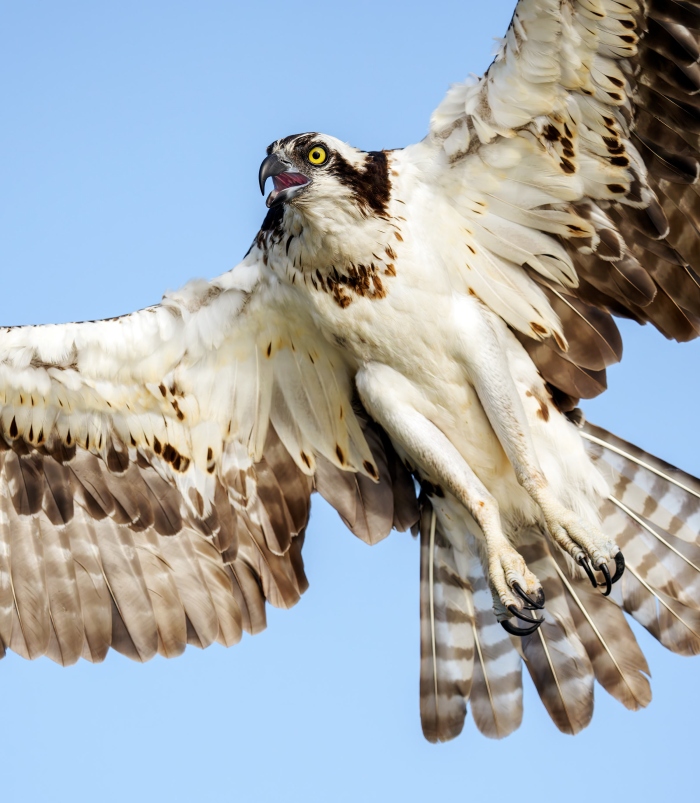
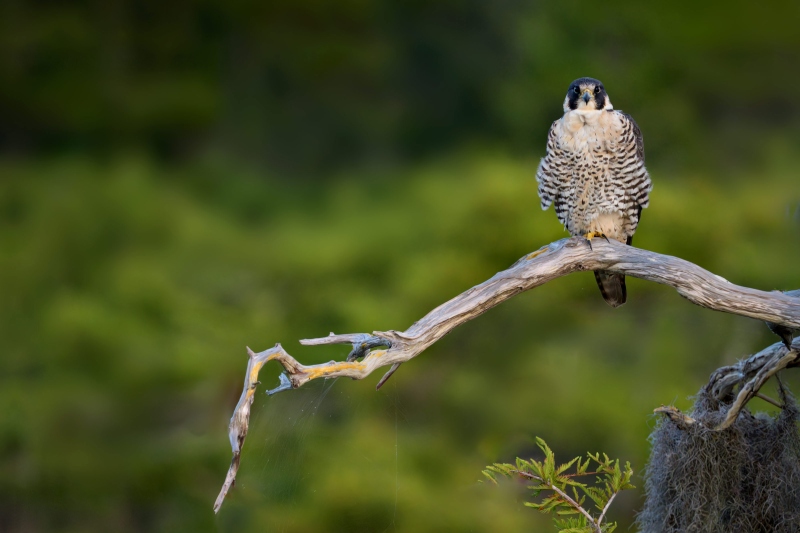






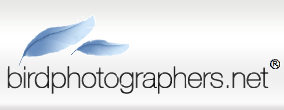


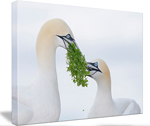
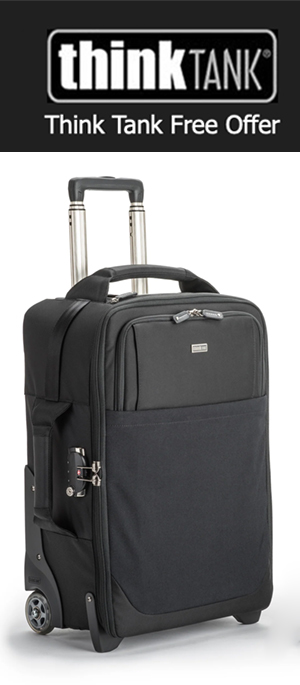


Before I mention my favorite picks, I want to echo what Dr. Cliff Oliver posted about his order from Bedford Camera. I had placed a pre order for the a1ii from Bedfords on February 6. I received it about a week ago and, as in Dr. Oliver’s case there was no tariff surcharge. Bedford’s honored the original price and I received the same “post order discount” using the BIRDSASART discount code. Nice!
As for the images in this post, I am drawn to #4 Osprey feeding chicks and #9 the Peregrine perched on a branch. The former for the pleasing composition and that it also shows some bird behavior, which is a bonus. # 9 has a nice clean background yet also gives a sense of habitat: it too is well composed.
Yo Adrian,
Enjoy your new camera body; it is amazing. And yesterday, Bedford rocks!
with love, artie
Lovely light and clean air which appeared to pay off well.
Hey Adam,
Nice to see you back.
a
Favorites: (1) Image 8, closeup of female taking flight, unlike any Osprey image I recall seeing, and (2) Image 4, Osprey feeding two chicks, because two chicks!, the symmetry, etc., again different than the normal adult + chick feeding image. Honorable mention to the handsome gator with water so clear it looks polarized.
Thanks for your picks and reasons. I could not argue with any of them.
with love, artie
Wow Artie, why am I surprised that you visited Lake Blue Cypress and came away with a spectacular gator pic? #1 for the win! it would be a beautiful pano if printed. the emerald portions in the water’s reflection really elevate the entire thing.
my second choice was almost one of the outstanding flight shots but #4 of the chicks being fed simultaneously is emotionally compelling. great composition on the peregrine too (spiderwebs and all)!
as always, great images Artie!
Thanks, Mishael,
The gator photograph was made in the canal along the road when we were leaving. When you see them from the boat, the are amazingly skittish. If we get out to Lake Blue Cypress when you visit, we should get to photograph the nest with the two chicks.
See you soon! With love, artie
Typo: Zooming practically all the day
Thanks and fixed (and further improved by re-crafting).
with love, a
My favorites are #1 and #5. The green reflections on the slowly moving ripples in the otherwise dark water convey a feeling of an impending stealthily attack on some unsuspecting victim just out of the frame. The osprey in #5 seems to be nesting on the head of some beast just above its right eye. Both images are special but #1 is the “bomb.”
Thanks, Warren. #1 is indeed sinister. I believe that the Osprey is just above the beast’s left eye.
with love, artie
Artie
DANG I love the Gator OMG as that was my hope and dream of my time in Florida so that dream still exists. lol just not to get eaten 🙂 like that Huge Piggy!
I do NOT LIKE #2 at all…………I Love it the color the streaks the design holy smokes you nailed it, so did you ever so slightly move the camera left to get the streaks? Amazing
The Osprey feeding the chick dudes is another favorite however I am floored by the Gator as all birds animals people and whatever may be in front of ones lens I try to create something as you my Friend have taught me! 🙂 Hello Anita….hugs the best ever companion for Artie to keep him on his toes!
Always with love b
OMG, Bob. Your comments always put a smile on my face.
with love, artie
Art: My favorite is #1, the alligator. The green water gives it a “moody” feel and the reflection is absolutely perfect — even the eye. My second choice is #3, the osprey in flight. Since I’m no longer able to do flight anymore I appreciate flight photos more than ever. By the way, it’s hard to believe that you can handhold the 400-800 zoom!
Thanks, Pat. I agree that the gator is pretty darn special. #3 was all about the east wind.
By the end of that great morning, I would admit that my left arm was feeling it. But the incredible versatility of the lens is hard to live without.
much love, artie
Re your rather rude and very public criticism of my comment the other day, when I said that your favourite image “didn’t do a lot for me”, I did at least apologise for it (something you omitted to mention), as I knew it was probably your favourite! As a retired professional engineer, I do not appreciate being ridiculed like the unfortunate Sue, not so long ago….!
As you said Artie, “there’s no accounting for taste” is there? How your Image 2 in this blog post could be described as a “pleasing blur” is quite beyond my comprehension! However, I am in awe of all your other Osprey images, particularly Image 8, which shows in great detail the bird’s stunning plumage. I appreciate your skill in capturing these images, augmented of course by the equipment you use, that I could never in a million years hope to own. So my choices are made by choosing an image that is pleasing on my eye, and that I would gladly hang on my wall, not by any great appreciation of exposures, ISOs, and all the other technicalities that go toward making a great image. The startled colt was one such image.
Good morning Maggi Fuller,
Lots to say here.
Public, certainly. Rude, however, is in the eye of the beholder. Many months ago I wrote you privately letting you know that I did not appreciate your going out of your way to post mostly negative comments. After that, you at least began including some positive comments.
Yesterday, “I did not ask which image is the worst?” Yet you took time out of your busy day to include something negative. Why??? What did you have to apologize for (unless you knew you were doing something wrong)?
As for the “unfortunate Sue,” she was delusional and did a fine job of ridiculing herself with her daily senseless comments. Those even after folks went out of their way to explain some stuff to her. I work very hard on the blog, usually averaging at least 10-12 hours a week. I put up with lots of crap, but I do have some boundaries. I eventually spammed Sue as I was unsure if she was some sort of bot or just testing my limits.
As for your telling me that there is no accounting for taste with regards to the mythical Osprey blur, I am fine with that. I am not insulted for several reasons. First of all, I think that it is a pretty neat image — a tree that looks like a bird. Secondly, you have stated repeatedly that you hate pretty much all blurs. And I am fine with that though I find your stance a bit close-minded. Lastly, only I can insult myself. When anyone else tries, I just ask myself, “Is that true?”
As for giving any credit at all to the gear I use, I would reply that lots of folks who have the very same gear have no clue as to how to create good images. Yes, the gear is amazing, the best in the world, but is totally worthless unless you know how to use it and get out of your living room to make images. That pretty much every single day since 25 OCT 2024.
Otherwise, thanks for your kind words.
Which startled colt image?
If I ask “Which is your least favorite?”, feel free. If, however, you go out of your way to post something negative in the future, you will be hearing from me again.
with love, artie